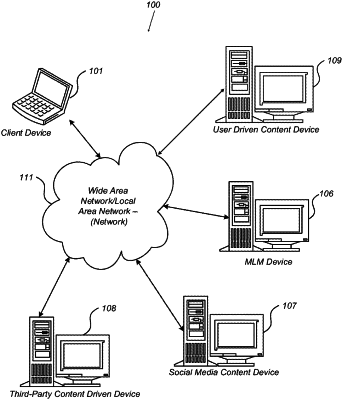| CPC G06Q 30/0201 (2013.01) [G06F 40/205 (2020.01); G06F 40/30 (2020.01); G06N 5/04 (2013.01); G06N 20/00 (2019.01); G06Q 50/01 (2013.01)] | 20 Claims |

|
1. A computer-implemented method for determining an entity's public reputation, the method being performed on a computing device and executed by a processor, the method comprising:
receiving, from a first device, entity-driven content associated with an entity in a format associated with the first device;
receiving, from a second device, third-party content associated with the entity in a format associated with the second device;
transforming:
the entity-driven content from the format associated with the first device to a common format based on semantic associations between attributes of the entity-driven content and predetermined attributes of a template-based reputation model, and
the third-party content from the format associated with the second device to the common format based on semantic associations between attributes of the third-party content and the predetermined attributes of the template-based reputation model;
receiving a reputation model from a predictive model based on:
the transformed entity-driven content in the common format and the transformed third-party content in the common format input to the predictive model,
wherein the predictive model is a machine-learning model that has been pre-trained to generate the reputational model for the entity based on attributes of the entity-driven content and attributes of the third-party content, and wherein pre-training the predictive model comprises:
extracting entity data from a content provider-specific dataset,
generating, for the entity data, at least one of: state vectors of attributes, treatment eligibilities, or ranking models based on content observations for different entities indicated by the entity data,
generating a training dataset based on the entity data and, and at least one of the state vectors of attributes, the treatment eligibilities, or the ranking models;
training, using the training dataset, the predictive model to generate reputational models for the entity based on attributes of the entity-driven content and the attributes of the third-party content,
validating an output of the predictive model using a validating dataset generated based on the entity data, and
calibrating, based on the validated output of the predictive model, the predictive model to generate the reputational model for the entity based on attributes of the entity-driven content and attributes of the third-party content;
comparing values for the predetermined attributes of the template-based reputation model to values for attributes of the reputation model for the entity;
generating, based on the comparing the values for the predetermined attributes of the template-based reputation model to the values for the attributes for the reputational model for the entity, a reputation score for the entity; and
sending, to a third device, an indication of the reputation score.
|